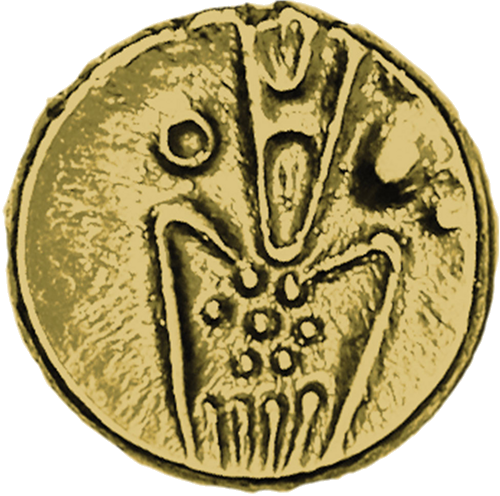


Obverse: Blank, without images or inscriptions – smooth surface with minor irregularities typical of hand-struck coins of the era.
Reverse: Stylized geometric symbol resembling a sacred Indian motif or floral ornament. The center shows circular dot patterns—often interpreted as lotus seeds or decorative details—surrounded by upward linear strokes. These symbols were typical of South Indian kingdoms, especially the Vijayanagar Empire (1336–1646), and later regional rulers.
About the coin:
This Dutch-Indian gold fanam, minted between 1639 and 1785, is one of the smallest gold coins in the world—its diameter is only 7.5 mm and weight 0.37 g. Despite its tiny size, it played an important role in international trade and became widely used under Dutch rule in South India.
Why was the fanam so successful?
It became iconic due to five main features:
Versatility: its low weight and value made it ideal for everyday transactions; several coins could be combined for larger purchases.
Minting technique: only the reverse was engraved, speeding up production. It depicted the simplified image of the goddess Kali with a seven-dot Tanjore rose on her chest.
Distinctiveness: unlike other fanams, this design featuring Kali and the rose made it unique and easily recognizable.
Reliability: valued by locals and seafaring traders for its portability and consistency.
Durability: made of gold, resistant to wear, heat, and humidity—making it a long-lasting trading medium.
For 146 years, the fanam facilitated the import of European goods such as weapons, horses, and tools, and supported the export of local products like rice, spices, and textiles. In everyday life, it could buy essentials such as food, spices, sugar, vegetables, fabrics, and basic services.
Although its creator remains unknown, numismatists such as Dr. Alexander Fishman believe it was influenced by earlier local Koromandel coinage. Its widespread use for nearly a century and a half proves its regional and international importance.
Specifications:
Era: 1639–1785 (Dutch India)
Origin: South India (Karnataka, Tamil Nadu, or Kerala)
Material: Gold (585–900 fineness)
Weight: 0.35–0.37 g
Diameter: 7–8 mm
Condition: Unrated
Theme: History
Age: Over 200 years
Number of items: 1